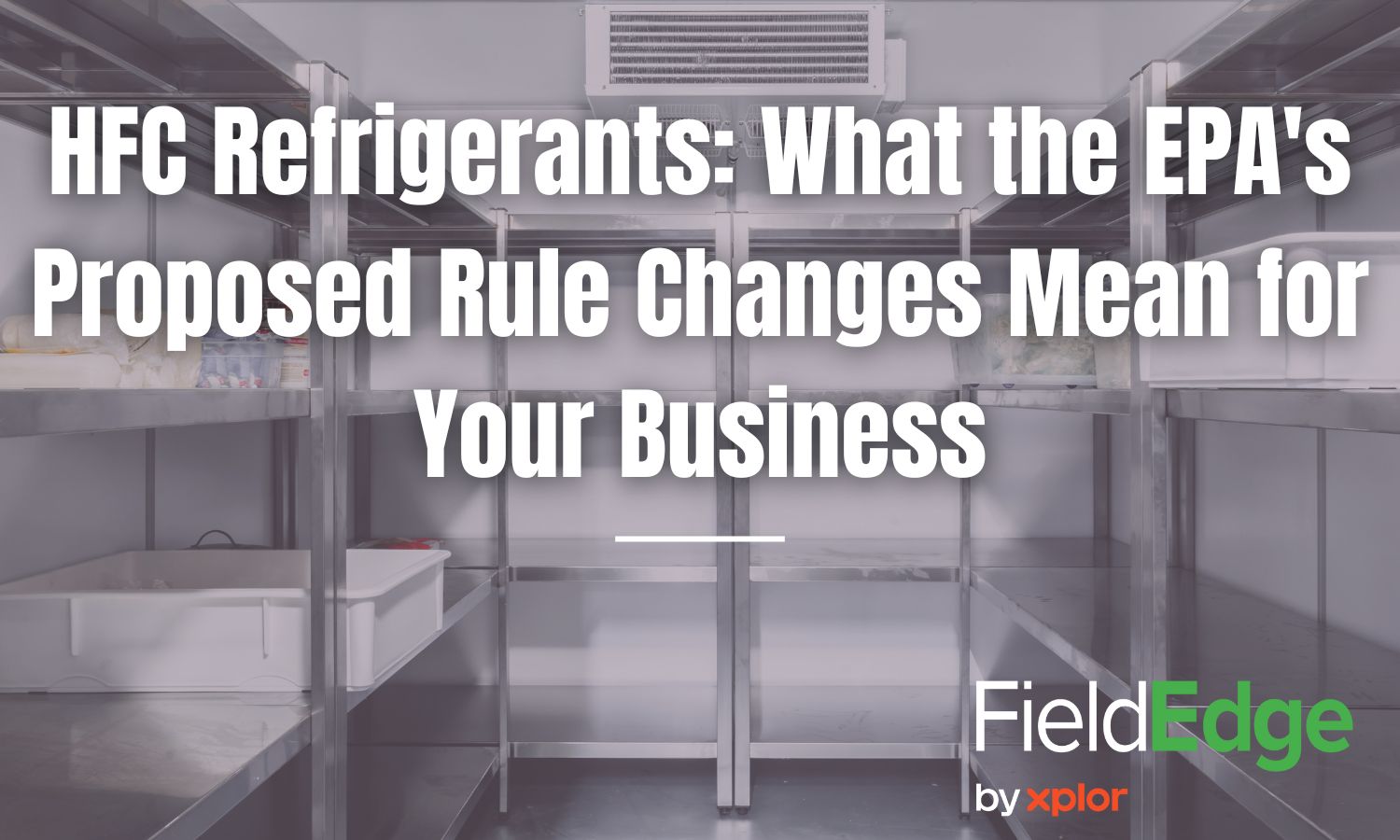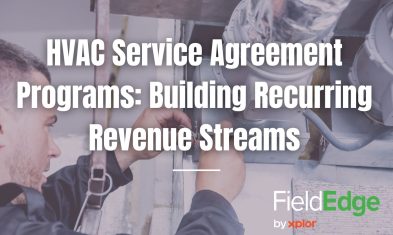If you run an HVAC or refrigeration company, you’ve probably heard the latest buzz around HFC refrigerants and maybe felt a little whiplash.
The EPA recently proposed updates to their Technology Transitions rule, part of the AIM Act’s effort to phase down high-GWP refrigerants. These proposed changes could delay some of the refrigerant transition deadlines, which might sound like a relief if you’re sitting on a R-410A inventory or juggling new A2L training requirements.
But not everyone is cheering. Some argue that changing course now will cause more confusion, drive up prices and penalize companies that already made the switch.
So, what does this mean for your business? Whether you’re an independent contractor or an expanding mid-market operation, we’ll break it down step by step.
At a Glance: What’s Changing with HFC Refrigerants?
The EPA’s proposed rule adjustments affect when and how you can sell, install and service equipment using HFC refrigerants.
Here’s what’s being discussed:
Residential and Light Commercial Systems
Equipment made or imported before 2025 could continue being installed past current deadlines. Which means, you can sell and install R-410A units from existing inventory, avoiding potential write-offs.
Retail Food and Cold Storage
The EPA wants to temporarily raise the Global Warming Potential (GWP) limits for commercial systems, allowing refrigerants up to 1,400 GWP through 2032 before dropping to stricter limits later.
Translation: This buys some time for contractors, distributors and supermarkets struggling to source low-GWP equipment. However, it could also complicate long-term planning.
Did You Know? As of September 2025, A2L refrigerant units comprised 80% of distributor sales—the transition is happening faster than expected.
Why the EPA Might Delay the Transition
The proposal came after pushback from distributors, grocers and manufacturers who said the original timeline (starting 2025–2026) was too aggressive.
Distributors and Wholesalers Need Relief
Organizations like HARDI warned that wholesalers are sitting on $500M+ in unsold R-410A inventory. Without a grace period, that stock could become unsellable.
Manufacturers Want Flexibility
Companies like Daikin support flexibility, arguing that regulations based on installation dates (instead of manufacturing) create logistical headaches for construction projects and VRV/VRF systems.
Retail and Grocery Stores Need More Time
Groups like FMI (The Food Industry Association) say smaller stores can’t keep up with the code updates, technician training or retrofit costs.
In short, many businesses are asking for time to catch up without taking massive financial hits.
Who’s Pushing Back (and Why)
Not everyone wants to slow down. Several manufacturers and trade groups say the delays create bigger problems.
AHRI Says Stick to the Plan
AHRI (Air-Conditioning, Heating and Refrigeration Institute) says the EPA should stay on track. Every state now has A2L refrigerants and delays could punish companies that already invested in updated systems.
Delays Could Raise Prices
Hillphoenix and others warn that postponing the transition could actually raise costs, since the AIM Act continues to cut HFC supply by 70% through 2029. Less supply + more demand = higher prices.
American Manufacturers Could Lose
Some industry groups fear that if the federal rollout slows, states like California or New York might create their own stricter rules: creating a confusing, patchwork of regulations for contractors to follow.
Fun Fact: Countries around the world are phasing out HFC refrigerants under the Montreal Protocol’s Kigali Amendment. The U.S. transition is part of a global movement toward cleaner refrigerants.
What This Means for Your Business
No matter where you fall on the issue, one thing’s certain: your strategy for inventory, training and customer communication needs to adapt now.
1. Manage Your Inventory Like a CFO
If you’ve stocked up on R-410A units, this proposal could help you clear that inventory, but don’t assume extensions are guaranteed. The EPA is still reviewing comments until November 21, 2025.
Consider:
- Audit what’s in your warehouse and when it was made.
- Move older inventory first and adjust pricing to stay competitive.
- Avoid over-ordering higher-GWP refrigerants; availability will only shrink from here.
2. Upskill Your Team Early
Even if the EPA extends the timeline, A2L refrigerants are the future. Your techs need to be ready before the rule takes effect.
Focus training on:
- Safe handling of mildly flammable refrigerants
- Leak detection and ventilation protocols
- Understanding new building codes and charge limits
Pro Tip! Training your techs now positions your business as the prepared partner when other companies are scrambling later.
3. Watch State Regulations
States in the U.S. Climate Alliance (like California, New York and Washington) often move faster than federal timelines. Stay plugged in so your business isn’t caught between conflicting rules.
4. Be the Expert for Your Customers
Your customers—whether its facility managers, small grocers or restaurant owners—are likely confused. Clear communication sets you apart:
- Explain what refrigerant their current systems uses
- Clarify when they really need to replace it
- Outline upgrade options and associated costs
The businesses that simplify this transition for their clients will earn long-term trust and repeat contracts.
Leverage Technology to Stay Ahead
Field service software like FieldEdge helps refrigeration and HVAC businesses:
- Track which customers use which refrigerants
- Schedule maintenance and inspections efficiently
- Manage inventory and compliance updates
- Streamline proposals for equipment upgrades
When refrigerant rules and inventory pressures are changing fast, having the right data at your fingertips protects your margins—and your reputation.
See how FieldEdge can help your team stay compliant, profitable and efficient. Book a FREE demo today!
Stay Ahead in the Transition from HFC to A2L
The EPA’s proposed changes to HFC refrigerant bring a mix of opportunity and uncertainty for HVAC and refrigeration businesses. Whether you’re relieved by the possible extensions or frustrated by the shifting timelines, one thing is clear: the move toward lower-GWP refrigerants isn’t stopping.
The real question isn’t if the transition will happen, but how prepared your business will be when it does.
Companies that stay informed, train their teams, manage inventory strategically and communicate clearly with customers will come out ahead. Those that wait for the final rule to drop risk getting stuck with stranded inventory, untrained technicians and customers who look elsewhere for answers.
The EPA’s comment period closes November 21, 2025, with final updates expected soon or after. Now is the time to double down on training, inventory audits and compliance tracking (so you’re not playing catch-up when regulations take effect).
Key Takeaways:
- The EPA is considering extended deadlines for several refrigerant categories, potentially saving businesses millions in stranded inventory.
- Supermarkets and cold storage facilities may continue using 1,400-GWP refrigerants through 2032 if approved.
- Distributors and manufacturers largely support the delay, while AHRI and some equipment makers oppose it.
- Start training technicians on A2L refrigerants now, regardless of when the final deadlines take effect.
- State regulations may outpace federal rules—check your local requirements regularly.
- Clear customer communication builds trust and long-term loyalty during the transition.
- Field service software like FieldEdge to stay organized as the industry evolves.
Remember, the final rule could still change. Stay proactive and connected through November 21 and beyond!
Stay tuned to FieldEdge’s blog for the latest updates on the HFC-to-A2L transition and other HVAC industry changes.
Related: Residential Efficiency Standards



